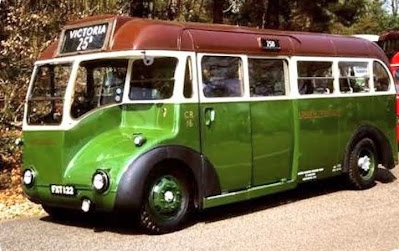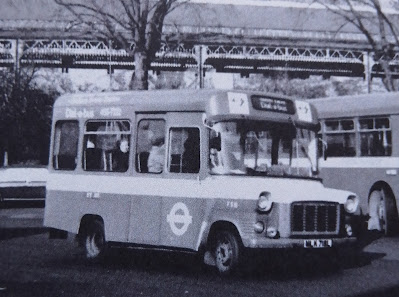Minibus Heaven Or Minibus Hell?
This book, published by Amberley at £16, flopped through the letterbox at fbb mansions onn the very day that the old man reached a horrific count of 78 years. No 1 son surely didn't pay full price and copies from the South American rain forest are on offer at about a fiver discount.
In simple terms it contains 96 A5 pages, each with at least two minibus illustrations thereupon. fbb was shocked. He simply did not realise that there were so many operators of minibuses while the ultimately failed craze was at its peak.
The book certainly gives the vehicle types a very good going over. There is a brief introduction and each picture has a short paragraph of supporting infromation - which is helpful.
fbb will begin, however, with his disappointment. The quality of the colour printing is disappointing - it felt "cheap" which it probably was - books are expensive. But here is FXT 122 from the book ...... and an on-line picture of the same vehicle.Both pictures are of the bus in well-cared-for and spit-and-polished preservation. All the book's colour pictures looked "dull" and the monochrome a bit "washed out".
Picky? Perhaps the old man is expecting too much for his son's money.
But there is much to be joyous about. Minibuses are often despised by "real enthusiasts" but they should not be.
Sadly there is no index and no contents list which means the reader tends to browse idly through the pages until he (or she) happens on something to catch their eye. There is certainly plenty of worthwhile eye-catching to be done. As there is no contents page, fbb will generously provide a list of Chapter Headings.
Precursors
Minibuses in the 70s
Small Bus Designs, 1950s-70s
1980s - Enter the "Bread Vans"
1980s - New Kinds on the Block
New and Lager Minibus Designs, 1980s-90s
Midibus and Short Bus Options, 1980s-99s
The Twenty=first Century Scene
In Preservation
fbb will also review some of the vehicles which "caught his eye"; but to enjoy the vast panoply of garish colours and weird bodywork, you will need to buy the book.
A couple of fbb faves. The Dial a Bus to Hampstead Garden suburb ...... and North Downs Croydon to Orpington ...... both of which were ridden by fbb in his youth.
Southern Vectis "bread vans" ...... in this case in the wrong colour and on the wrong route. It should be blue and branded "Wanderer". For a while the Ryde locals ran up and down the pier carrying zero passengers - OK, looking at the above picture, nearly zero!fbb did "enjoy" an occasional ride on a Blue Line minibus including the little ones, not in the book.Irrespective of size, the ride was always really uncomfortable! fbb also enjoyed the short lived Red Admiral over on the mainland, Badgerline competing against the incumbent and later becoming First.Bob Montgomery arrived in Sheffield hot foot from a minibus revolution in Manchester and promptly turned the busy cross-city double deck 52 into a disaster with his Eager Beavers ...... seen above on a less contentious operation. The Beavers soon left the 52 and Bob soon left Sheffield. As a result of this resounding success (?) he eventually became boss or Stagecoach Bus, but a wiser and minibus-less man.
Of course, the book does not ignore more "normal" small bus operation before, during and after the minibus mania. Here is friendly cooperation between Penzance and Mousehole.It became apparent that the benefits of the cheap and not very cheerful minibus were not what they were claimed to be. The increased frequency did not bring in enough pennies to pay for the increased operating costs despite low vehicle running costs; so minibuses got bigger ...... and gained two doors to speed loading.
What a good idea - why has that not been thought of for bigger vehicles?
Author Malcolm touches briefly on the modern outbreaks of the mania with a picture of Arriva Click ......which is a brand close to extinction if it hasn't already been extincted!
We now have "small buses" with big capacity ...... thus beginning to recreate the discomfort of the bread van, but now with an overall increase in the cramped size!
Of course there were brand names as well as weird liveries, but fbb's favourite came from Burnley and Pendle before Stagecoach, before Blazefield and before Transdev.Whizzard!
Ideal for a trip to the Harry Potter Studios? Snort. Groan?
You aged blogger is well aware that most enthusiasts like books about the buses. In this dainty volume you will get loads of detail about chassis, bodywork, engines and the shape of wheel nuts - which is great if that "floats your boat" - or maybe "propels your PSV".
fbb would have liked to read more about some of the networks and their longevity (or shortevity as was more common!).
Also, it is time somebody with inside information wrote a word or two about the (failed?) economics of the minibus mania.
Why were they a failure? Why is today's "Uber-style" DRT operation a guaranteed failure? Why does your chewing gum lose its flavour on the bedpost overnight?
WE SHOULD BE TOLD!
Seriously, though, it would be good to see some of the sums.
Maybe Keith Shayshutt should pen a further volume on the philosophy and finances of the minibus revolution.
There were a load of small buses at Western National in 1996 serving a significant expansion (re-expansion) of the network. Only general information is provided about the performance of each route. fbb wonders what the detail might show.
But Malcom Batten's book is a good overview of the mania, perhaps a little too positive in places, but factual nevertheless.
Well worth a read!
Or you could think about 18 seats (comfort, what comfort?) from King Alfred in 1931.What goes around, comes around!
"Gary were'nt too shooer where Wales were but 'e thowt it were out east t'wards Worksop.
Ay oop! 'Ee didn't know 't'village 'ad a flag! Lad did 'is bestest under t'circumstances."





















fbb's comments on the Ryde Pier bus picture are wrong - as the blind shows, it was on the service to Newport, and therefore correctly run by a Newport-allocated Medinalinx bus. I heard that Stuart Linn chose the route number based on the headcode of the fast Portsmouth to Waterloo trains, with which the service was designed to connect.
ReplyDeleteSadly, washed out colours and, often, sloppy editing are about par for the course with Amberley's productions. The recent book on Sheffield has some ghastly examples including a Dominator which looks as if the image has been taken out of a cmaera too quickly and fogged. On the subject of mis-spellings FBB will no doubt be suitably appalled that a recent SYPTE diversion notice close to his ancestral seat referred to 'Barnfield Road' and 'Hallamshire Lane' (should be Barncliffe Road- Barnfield Road is a mile away- and Hallamshire Road)- another PTE publicity 'triumph'.
ReplyDeleteIt's interesting that if you go to Turkey you will find "dolmuses" operating services, in addition to or instead of "proper" buses. These are privately-owned vehicles, usually painted white and akin to Malcolm's photo above of the Arriva Click vehicle. They operate on fixed routes and have set fares, and are presumably licensed by the local Council. They do require a good deal of honesty and the fare money is passed from hand to hand until it reaches the driver, with the change coming back the other way! There is no timetable but they seem to run frequently. I have found something similar in Ziguinchor (Senegal) although the vehicles there had conductors to take the fares, with entry and exit via the rear doors - mind you, that was over 30 years ago!
ReplyDeleteWhether the minibus operations of the 1980's were a failure is debatable. In the early years of deregulation, many operators saw a need to try to protect their services from potential new competitors. Increasing the frequency was seen as a way to make the task of a potential competitor significantly more difficult. A more frequent service is also likely to be more attractive to passengers; and smaller vehicles, with a correspondingly smaller number of passengers could, theoretically, offer faster journey times.
ReplyDeleteConventional wisdom seems to say that the minibuses were too small to enable the operators to run them commercially. But taxis can (presumably) earn profit for their proprietors with just 1 passenger....
RC169
Many minibus services/networks saw astounding passenger growth and were profitable. Unfortunately they then required bigger vehicles which had running costs much greater than the Ford Transits they typically replaced. In addition driver costs, in real terms, gradually increased and hence the traditional bus industry of larger vehicles /reduced frequencies came into play. However, many networks were dramatically rejuvenated by minibuses and the friendly drivers/simpler fares/better marketing that went with them. The real winner was the high frequency- a Leyland National would arguably have achieved the same, but of course trebling or quadrupling the frequency with these would have been totally unaffordable!
ReplyDelete